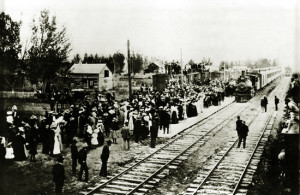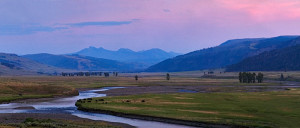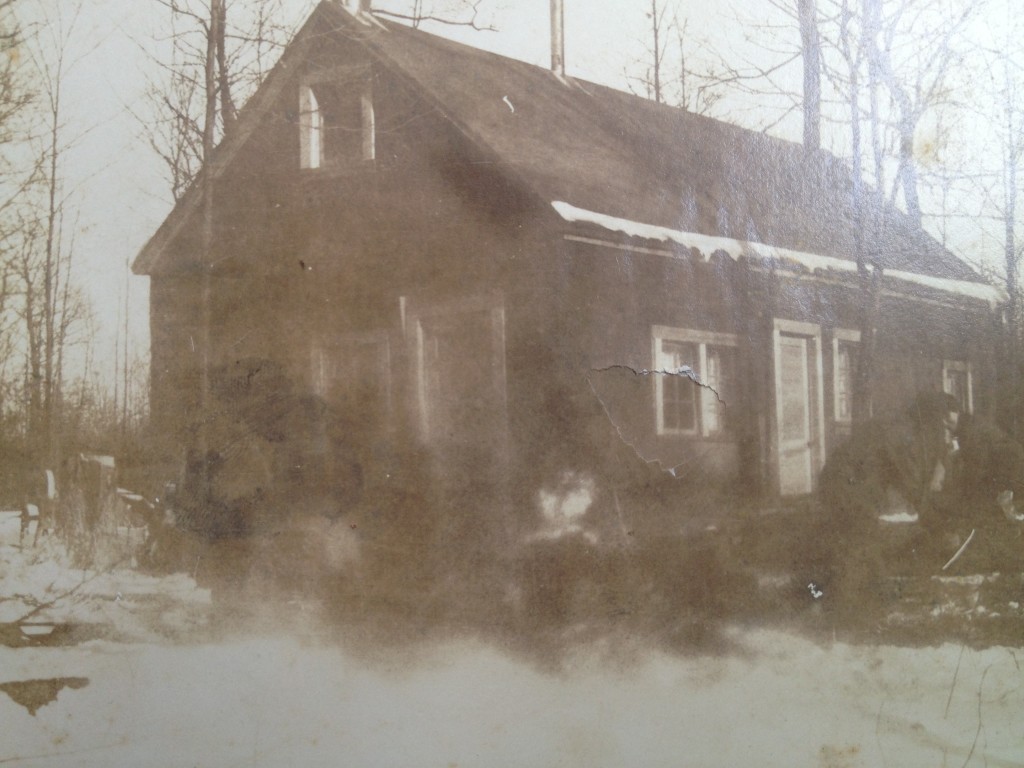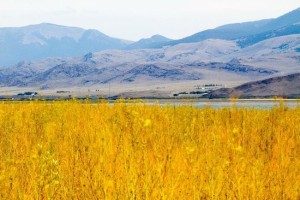THE SMITH HOMESTEAD in WISCONSIN (circa 1932)
From Mt. Airy, VA to Clark County, WI
How does this happen? In 150 years of time, over the course of four generations, Smiths migrated from the plantations of Westmoreland, Virginia to the backwoods setting in Clark County, Wisconsin (circa 1930). Three of the four Smith children can be found in the foreground of the blurred image of the Clark County home.
In Britain, plantations and manors were often willed off to the oldest surviving son. That practice continued to some extent in the colonies. However, with each generation new wrinkles appeared in family procedures related to land ownership. Dowries given to young suitors of Smith women took some acreage away from the family stockpile of land. The practice of subdividing the land equally among the children began chipping further away into the family estate. The plantation home would still go to the oldest son but acreage in other parts of several counties would be parceled out. When Peter of Westmoreland subdivided his parcels of land at Bull Run into three equal shares in 1741 he set each of three sons up for the next decade. Or so he hoped. An erratic market, a failing soil and the Revolutionary War created hardships for many. The lure of western lands caused families to sell their stake on the Piedmont and they walked away from Virginia history into a Wilderness requiring a new lifestyle, new skills, less bling and more sweat than ever. The mansion scene was less relevant. In fact, a cabin within a stockade offered a better chance for survival, but not always. But you already know that if you tripped across the Davis, Stille or Kincheloe roots of our family tree.
Opportunities for career advancement and the market place were distant in the hills of Kentucky and Indiana. A review of the early census records for Kentucky, Indiana and Illinois reveal that men were farmers and women housekeepers. Census records initially recorded the birth place of our ancestors as North Carolina and Virginia. My great great grandfather, (ggf2) Peter Smith of Posey was born in Caswell County NC, lived for a time in Kentucky with his parents, George and Lydia Smith, and he migrated with his parents to Posey, Indiana. In his later life, Peter (ggf2) accompanied his adult son (ggf1), James Monroe Smith to the coal fields of Southern Illinois.
Peter of Posey’s journey represents the rapid American migration of pioneers. Smith siblings and cousins witnessed the expansion of tobacco fields and growth of cotton in North Carolina, the growth of the coal industry in the Kentucky hills and the harvest of wheat and corn on the Great Plains. We will explore their transition from plantation owners to farmers to miners eking out a living in the squalor of mines.
The coal mines came into play in both Kentucky and Southern Illinois. The disastrous effect that Mr. Peabody’s mine had on family properties in Paradise, Kentucky is discussed in a separate chapter. You have probably heard the John Prine song, covered by John Denver, Tom T. Hall, Jimmy Buffett and a host of other recording artists. That piece of music and the history it captures has also been examined elsewhere in this conglomeration of thoughts. Smiths were found in the mines of Southern Illinois in the early 1900s. Online records reveal the names of a number of Smiths, neighbors and friends who died tragically in mining catastrophes. That too has to be discussed.
I don’t know if you have seen the History Channel documentary on Mother Jones and her attempt to help the coal miners of this country, but our family benefitted from her efforts. If you are one who believes the union needs to be eradicated, you might want to savor the fact that your ancestors found some comfort in the brotherhood of the miner’s union. If you believe corporate America is good, capitalism great and can do no wrong, consider what happened to your family history as Mr. Peabody got the better of them. There has to be some middle ground. This is just my plea for all things in moderation. Sorry to have stepped on the soap box for a moment. But, having researched this aspect of our family history, I begin to understand my father’s progressive leanings.
Over the generations the median income of a Smith family member dwindled as they moved from plantation life to the four walled cabins with a loft where the kids could sleep. Changing the straw in the loft was tantamount to flipping the mattress in 2016. I can’t imagine Elizabeth Tayloe Smith (ggm5) wife of James Smith (ggf5) having to touch bedding in her stately home. I am sure there was a slave (referred to probably as a servant) to make the bed each day. I don’t fault Elizabeth and perhaps I envy her the wealth that she had at her disposal, but if a little of that trickled into the pockets of Leb, it might have been a good thing. Things did turn out well though, for all concerned.
Dad (JD for James Donald) once told me that Leb counted on his kids to chop the wood for heat and cooking. Leb’s daughter, my Aunt Marge Smith Jacobs, was not about to be left out of chores. She would insist on chopping right alongside her younger brothers: Bob, Bill and Don (as he grew older). I believe the photo shows Marge (to the front and center of the cabin photo) along with two of her brothers cutting and piling wood to the right of her. They also removed manure from their cattle pasture, and packed the sides of the house with the crap to slow the penetrating winter wind. It provided some insulation against the bitter cold so popular here in the Northwoods of Wisconsin. We have that below zero cold today as I write and I am grateful there is enough fuel in the tank to keep me warm. I would hate to rely on Murphy, my Golden Retriever, for the organic materials needed to wall the foundation of my house. Although the dang turkeys that come through here might be leaving enough dung for me to …. no, never mind. In the Spring, the dung would come off the Smith’s house and go onto their garden plot. The cycle of life, making use of anything and everything that can get you through the day and year.
Leb Smith had a tough go of it in life and never complained, as far as I could tell. He was laid back before being laid back was fashionable. It may have been the daily dose of medicine he took. Gin seemed to have a healing effect. He left school with a fourth grade education and that was probably a new low for Smith kids over the course of our first three hundred years in the New World. Many of his ancestors benefitted from tutors, private school education and a better academic preparation than Leb would acquire. But if street smarts were becoming important on the Great Plains he had them in spades. We just didn’t have streets, per se, in Montana and the Dakota Territory. A buffalo trace provided enough of a path if one knew the migration patterns of the majestic beast. Following an Indian Path could lead to trouble as Custer was apt to point out in his final siloloquy. The fact that Mary Hughes Smith would teach in a little one room Dakota Territory school house just off a Sioux path has always been a fascinating image in my mind.
Leb found it necessary to leave school and provide for his family. He wasn’t yet born when James Monroe Smith’s oldest child, Peter Smith, passed away at age 12 in 1880. When Leb was born in 1883 he quickly became the spoiled brother of five older sisters, some of whom never really knew him. As and example: the age difference between Leb (b. 1883) and his oldest sister Nancy (b. 1869) was fourteen years. She was, by pioneer standards, a young woman before he developed a capacity to remember childhood.
Lebanon Ferris Smith, was born in West Frankfort, Illinois on June 3, 1883. Had he gone to high school there he would have been a ‘Redbird.’ But as I said, he dropped out in fourth grade. His mother, Jane (Stilley) let her husband James Monroe Smith know that Leb would be the last of the litter. Eight kids would be enough. But she would be wrong. Records show that a child, Gracie, was born three years later in 1886. And Jane turned out to be right after all when the baby failed to survive. That happened all too often in the course of history. Leb turned out to be the youngest of the lot but mother Jane would always be a care provider to her children and grand children.
Leb had one brother, Davis Smith, and five sisters. The names Davis and Smith were surnames (last names) of a line of our ancestors who played an essential role in the settlement and survival of the first British colonies in North America. Smith and Davis family members were among the first of the pioneers to settle Virginia, North Carolina, Kentucky, Indiana and Illinois. Via the Davis roots we have been linked up with the Stille(y) heritage covered elsewhere in this anthology.
Talk about being the first to arrive, the Stille(y) folks were literally the first in New Amsterdam, New Sweden and Southern Illinois. In studying our ancestry we often forget the fact that there are a host of families who make up our heritage. I am not just a Smith. But I don’t want to stress that too much. I mentioned George Armstrong Custer earlier…. Well… I know George Rudolphus Smith (ggf3) married Sarah Armstrong just after my grandmother (ggm3) Lydia Tate passed away. I am afraid to research the Armstrong link for fear I will find I am some sort of a second step cousin six times removed and once by a tomahawk. I do know there are some pretty cool Armstrongs in those roots going back in time before Custer inherited his golden locks and swag.
 The youngest of the two boys, Leb and Davis Smith worked the family farm until the notion came upon them that they should head west. Again, according to my father: At age 21, Leb rode the train west to DuBois, Wyoming. The train track provided tourists with a path to Yellowstone Park, the nation’s first national park (created in 1872). I would like to say that crowds gathered at the rail station to greet the legendary Lebanon, but this is a picture of the crowd awaiting the arrival of a ‘first train’ in Casper, Wyoming, circa 1904. Teddy Roosevelt was in his third year as President of the United States. Roosevelt had already become legend as a Rough Rider. The time Roosevelt spent in North Dakota as a youth enhanced his image as a rough and tumble guy. Roosevelt identified with the herdsman of the Great Plains, the cowboys of the Wild West. The cowboy, he wrote, “does possess, to a very high degree, the stern, manly qualities that are invaluable to a nation.” His articles about frontier life, written for national magazines, and three published books caught the attention of young men like Lebanon Smith, a man who could barely read the words but understood the message. Teddy and Franklin Roosevelt share a grandfather with my brother-in-law Keith Wetherell and his children, Mike and Treva. They all have Delano blood in the gas tank.
The youngest of the two boys, Leb and Davis Smith worked the family farm until the notion came upon them that they should head west. Again, according to my father: At age 21, Leb rode the train west to DuBois, Wyoming. The train track provided tourists with a path to Yellowstone Park, the nation’s first national park (created in 1872). I would like to say that crowds gathered at the rail station to greet the legendary Lebanon, but this is a picture of the crowd awaiting the arrival of a ‘first train’ in Casper, Wyoming, circa 1904. Teddy Roosevelt was in his third year as President of the United States. Roosevelt had already become legend as a Rough Rider. The time Roosevelt spent in North Dakota as a youth enhanced his image as a rough and tumble guy. Roosevelt identified with the herdsman of the Great Plains, the cowboys of the Wild West. The cowboy, he wrote, “does possess, to a very high degree, the stern, manly qualities that are invaluable to a nation.” His articles about frontier life, written for national magazines, and three published books caught the attention of young men like Lebanon Smith, a man who could barely read the words but understood the message. Teddy and Franklin Roosevelt share a grandfather with my brother-in-law Keith Wetherell and his children, Mike and Treva. They all have Delano blood in the gas tank.
Leb joined his brother Dave in Pocatello, Idaho and was soon employed at the Reno ranch. The Reno Ranch wasn’t just any ranch out west. For whatever reason, destiny found our guys working on the 2200 acre spread of one James H. Brady. Brady, a Leavenworth Kansas College Grad had taken his earnings as a real estate salesman to Idaho in 1895 and purchased enough land to create his ranch. Leb and Dave herded cattle and sheep for the man while Brady established himself as the state’s governor. Brady lost his reelection bid but stayed in politics and later earned a seat as the United States Senator from Idaho in 1913. Leb and Dave were long gone at that point in time. Leb’s spurs from that adventure sit on a shelf above my desk here in the Northwoods of Wisconsin. Grampa had countless stories to tell about his life as a cowboy.
 Dad seemed to recall that Leb and Davis spent some time herding sheep in the Lamar Valley of Yellowstone south of Livingston, Montana. It was during that time in Montana that Leb learned to pick up a rattle snake, spit tobacco juice in the eyes of the serpent and use it as a walking stick. I was glad that we were hard pressed to find a rattlesnake on his farm in Minnesota in 1955 or his back yard in Auburn, Alabama in 1962. I did not want to test the accuracy of his story or spoil the magic his stories created.
Dad seemed to recall that Leb and Davis spent some time herding sheep in the Lamar Valley of Yellowstone south of Livingston, Montana. It was during that time in Montana that Leb learned to pick up a rattle snake, spit tobacco juice in the eyes of the serpent and use it as a walking stick. I was glad that we were hard pressed to find a rattlesnake on his farm in Minnesota in 1955 or his back yard in Auburn, Alabama in 1962. I did not want to test the accuracy of his story or spoil the magic his stories created.
Over the course of one month in particular in Montana or Idaho, it was Leb’s job to insure that a particular bull did not enter the pen with the cows except when dictated by management. Leb did his job, the bull never got close to the cows and the bull only grew more frustrated. The bull’s snorting and macho displays of affection became constant. But the bull could never succeed in getting what he so desired. One day, however, a twister came through the valley. Leb and Dave took shelter and survived the storm. As Leb reported it to me: “The twister lifted that damn bull up and carried that critter over the fence into the field with the cows. The bull was stunned by his good luck and once he recovered from the shock he was soon making his rounds with the ladies.” According to Grampa, they had quite a few calves that spring that were not part of the management plan. In the years I lived in Montana we never once heard of a twister, but again, I did not want to research the history of the state’s weather conditions. There are some things in our family history that should remain as ’truth’.
Leb and Dave eventually left the Reno ranch and separated for a moment in time. Leb worked alone one bitter winter at a grain elevator in Dillon, Montana at the foot of the Pioneer Mountains, in the Beaverhead River Valley. Dave headed east into the breaks of the Red River Valley of North Dakota (statehood: 1889). Leb would retreat from the isolation found in the remote ranch town of Dillon and head east to find Dave conjuring up their next adventure.
My father’s story telling continued as he licked the smoke from a Corona Cigar. Davis (aka Dave) Smith had located a large tract of wheat fields that could be rented from a Swede by the name of Carlson.
Dave and Leb Smith were right at home living among the Scandinavians of the Dakotas and Minnesota. Leb’s mother, Jane Stilley, was of Swedish and Dutch descent. The Stilley family was originally from the islands in the Gulf of Bothnia, north and east of Stockholm, Sweden circa 1600. [It was in 1638 that Olaf Stille escaped the wrath of an aristocratic land lady and ventured to Christiana, New Sweden. That sounds so much more pristine than saying Hoboken, New Jersey. Olaf’s adventures are recounted elsewhere in here. He was a swash buckling farmer with an Errol Flynn flare for life.]
Dave and Leb struck a deal, renting land from Carlson and putting together a successful operation. Their mother, Jane, came up from Southern Illinois and acted as cook and chaperone. Her husband (Leb and Dave’s father) James Monroe Smith, had taken leave of his farm in West Frankfort to construct a home in Anna, in southern Illinois. I believe he was helping one of his girls on a renovation project, or in the process of moving to a new homestead. At any rate, a tree that he was felling dropped on James and crushed him in 1910. Jane was made a widow and her sons were more than happy to have her company and her love in the desolate Dakotas. Wheat prices during World War I were high enough to allow Leb to put together a nest egg that allowed he and his wife, Mary Hughes, to afford 440 acres of farm land in Neilsville, Wisconsin.
My earliest memory of my grandfather dates back to a winter in Eyota, Minnesota around 1955. It was a frigid Christmas and the snow was deep outside his two story wood frame farm house on the edge of town. A wood burning stove served double duty as a source of heat and as an oven for preparing meals. Modern conveniences were hard to come by for a hard scrabble farmer. The outhouse was a cold place and a guy would rather stay under the down comforters in the chilly upstairs bedroom than risk frostbite outside. I imagined that I might be frozen to the toilet seat if I sat too long in the dark of night. So I usually skipped supper.
My grandfather walked me outside to show me the sheep, the cattle and a few chickens. Clouds formed above their heads as the critters took shallow breaths and exhaled. He pointed to the outhouse and apologized for not having installed the indoor plumbing just yet. As he drew air through his tobacco pipe, I noticed that he held it with only one half a hand. Several of his fingers appeared to be missing. They were stubs of their former selves. “Cut them in a damn drive chain on a farm some time ago,” he mumbled. I marveled at the fact that he was still alive. In the middle of my awestruck moment a large goose scurried by, chased by a ram. “That damn goose hasn’t long too live. Christmas dinner you know.” The goose farted a terrible blast, as if to comment on Grampa’s death sentence. My grandfather waved his hand, clearing the air a few times and mumbled, “This too shall pass.”
Many years later in my role as a school administrator, I would attend long, laborious school board meetings. In an effort to escape near death experiences at the hands of a few patrons, I would often picture my grandfather, his pipe in hand, and the “damn goose.” As folks droned on into the evening meeting I would remind myself: “This too shall pass.” I called this ‘The Fart Theory’ in courses that I taught on Educational Leadership.
Of all the teachers and professors I have ever met I have yet to find one whose education matches that of the sage who was my grandfather, Leb. More about Leb and my grandmother Mary at a later date. I can’t ignore my grandmother, Mary. Her Irish heritage alone causes me to think of myself as an Irishman. All this English and German ancestry running through me and I think of myself as Celtic. I don’t know. It must be something I inherited from my father who was after all, half Irish. We will start sewing all of these pieces together into a tapestry that does bind us all together. While my grandfather Leb conducted himself in the proud manner of an Irishman, he had not a drop of the blood in his system that I can find. And to my knowledge the Irish drink whiskey with their stout, not gin. Leb may have had some Celtic blood, Welsh maybe, depending on roots of our ‘Peeter’ Smith (d. 1691).





